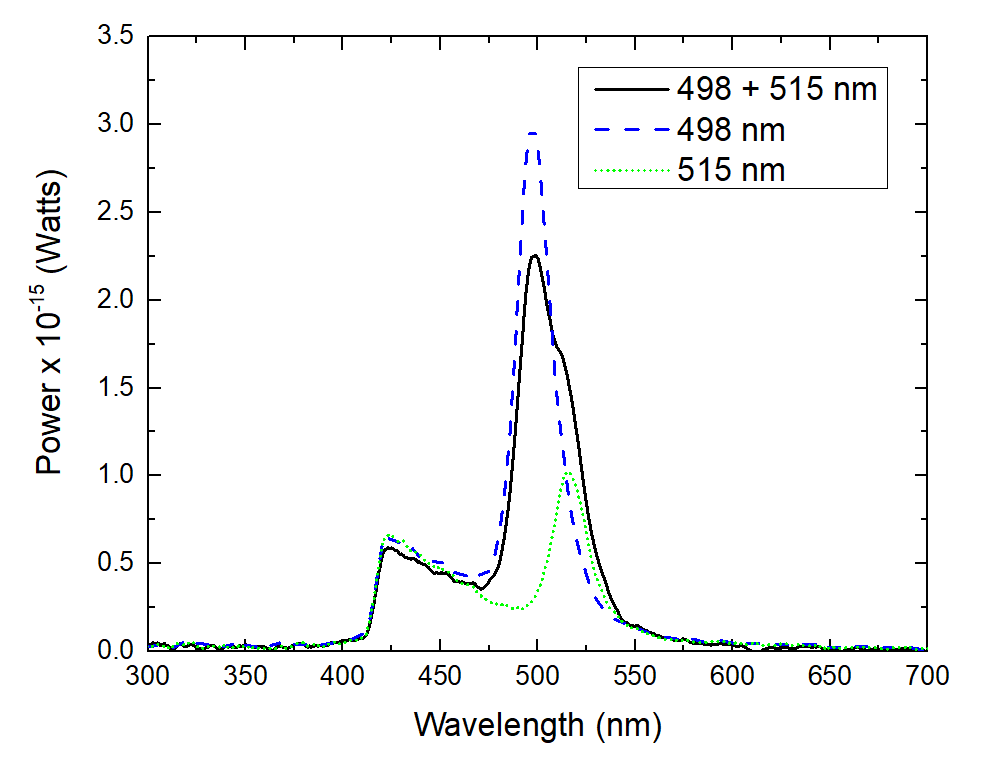2022 Annual Meeting
(508d) Elucidating the Relationship between Surface Chemistry of CsPbX3 Perovskites and Their Transition Dipole Moment for Energy Transfer and Optoelectronics
Authors
Evidence suggests that the transition dipole moment of perovskite nanocrystals is highly controllable based on the composition of the substrate [2]. This unique property of perovskites points to tunability based on their surface interactions, and goes beyond the tunability of other classes of materials (i.e. CdSe quantum dots) which may only be tuned based on their optical environment. Here, we extend this study by introducing an energy gradient.
Following the work of Brown et. al. [3], CsPbBr3 nanocrystals were synthesized. Characterization via photoluminescence spectroscopy shows wavelength tunability between 508 to 514 nm using octylphosphonic acid ligand concentrations from 0.6 M to 0.3 M. Thin films were fabricated by spin coating layers of nanocrystals onto a glass substrate. The figure reveals the photoluminescence of CsPbBr3 films where size effects are used to vary the emission wavelength. Energy may only be transferred from higher energy to lower energy, so, in the presence of a higher energy emitter, signal of a lower energy emitter should be exaggerated if energy is being transferred, and signal of the higher energy emitter should be diminished. This is qualitatively shown by our initial characterizations.
Knowing that the optical environment plays a strong role on the light emission direction, our approach is to vary the morphology, assembly, and environment of the particles and use UV-vis spectroscopy techniques to measure the magnitude of the parallel vs forward propagating photoluminescence. TEM will further confirm particle alignment, and Back Focal Plane (Fourier) imaging will address the emission pattern for various optoelectronic configurations. The combination of these measurements will show how the light and energy direction is affected by the combined effects of surface interactions and energy transfer gradients.
[1] L. Protesescu, S. Yakunin, M. I. Bodnarchuk, F. Krieg, R. Caputo, C. H. Hendon, R. X. Yang, A. Walsh, and M. V Kovalenko, Nanocrystals of Cesium Lead Halide Perovskites (CsPbX3, X = Cl, Br, and I): Novel Optoelectronic Materials Showing Bright Emission with Wide Color Gamut, Nano Lett. 15, 3692 (2015).
[2] M. J. Jurow, T. Morgenstern, C. Eisler, J. Kang, E. Penzo, M. Do, M. Engelmayer, W. T. Osowiecki, Y. Bekenstein, C. Tassone, L. W. Wang, A. P. Alivisatos, W. Brütting, and Y. Liu, Manipulating the Transition Dipole Moment of CsPbBr 3 Perovskite Nanocrystals for Superior Optical Properties, Nano Lett. 19, 2489 (2019).
[3] Alasdair A. M. Brown, Parth Vashishtha, Thomas J. N. Hooper, Yan Fong Ng, Gautam V. Nutan, Yanan Fang, David Giovanni, Ju Nie Tey, Liudi Jiang, Bahulayan Damodaran, Tze Chien Sum, Suan Hui Pu, Subodh G. Mhaisalkar, and Nripan Mathews, Precise Control of CsPbBr3 Perovskite Nanocrystal Growth at Room Temperature: Size Tunability and Synthetic Insights, Chemistry of Materials 2021 33 (7), 2387-2397
